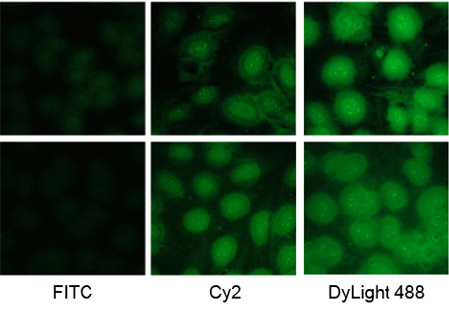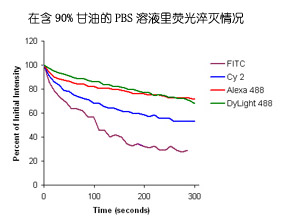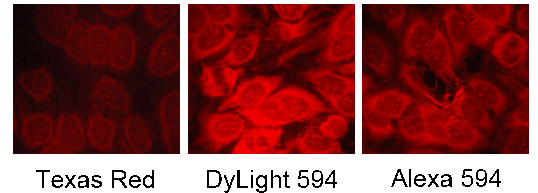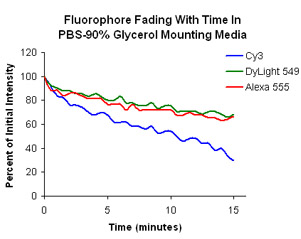As the name implies, a fluorescent secondary antibody usually refers to a secondary antibody with a fluorophore label. Such a secondary antibody can determine its secondary antibody content by observing the intensity of its fluorescence at different wavelengths. Common fluorophores include FITC, Rhodamine, Texas Red, PE, Cy series, and the like. For example, FITC, fluorescein isothiocyanate, is currently the most widely used fluorescein. The maximum absorption light wavelength is 490-495 nm, and the maximum emission light wavelength is 520-530 nm, showing bright yellow-green fluorescence. The advantage is that the molecular weight is 389.4, each antibody can label several FITC molecules, and the human eye is sensitive to yellow-green, so it has a good contrast and its shortcoming is rapid quenching. Rhodamin and its derivatives are a group of fluorescein with yellow-red fluorescence, including TRITC, Texas Red and so on. Rhodamine and its derivatives are contrasted with FITC's green fluorescence and can be used for double labeling or contrast staining. Due to its slow fluorescence quenching, it can also be used for labeling staining alone, but its fluorescence intensity is weak, and Rhodamin is weaker than Texas Red. Amy Jie can provide customers with a full range of imported fluorescent secondary antibodies, including fluorescent secondary antibodies in Jackson's large packaged powder form. In addition, Abbkine's small package liquid form fluorescent secondary antibodies are also available, all with high cost performance. . For more secondary products, please see: Amyjie secondary antibody products.
Cycadin Cy is another type of fluorophore, including green Cy2, yellow-red Cy3, red Cy5, near-infrared Cy5.5 and other fluorescent dyes. Due to the slight difference in structure, the absorption and emission wavelengths are also different. For example, the Cy2 coupling group has an excitation wavelength of 492 nm and emits green visible light having a wavelength of 510 nm. Cy2 and FITC use the same filter, but avoid using a seal containing phosphorylated phenylenediamine, because this anti-quenching agent reacts with Cy2, resulting in weak fluorescence and diffusion after storage of the stained sheet. Cy3 and Cy5 are brighter, more stable, and have a weaker background than other fluorophore probes. The maximum wavelength of the excitation light of the Cy3 coupling group is 550 nm, and the strongest emission light is 570 nm. Since the excitation and emission wavelengths are very close to TRITC, in fluorescence microscopy, the same filter as TRITC can be used. Cy5 can be used in multi-label experiments with many other fluorophores. Since its maximum emission wavelength is 670 nm, Cy5 is difficult to observe with the naked eye, and it cannot be excited by a mercury lamp. Confocal microscopy with suitable excitation and far-infrared detectors is typically used when viewing Cy5. Below we look at a comparison of a set of fluorescent secondary antibodies:
 Â
 
We know that the green fluorescence intensity of FITC is already very bright, but from the top left, it is still weaker than Cy2, while Dylight 488 is better; the upper right is different fluorophores containing 90% glycerol. The fluorescence quenching condition in PBS is visible from the figure. The quenching of FITC is very fast, followed by Cy2, while Dylight 488 and Alexa 488 have good light stability. Let's look at another set of data about red fluorescence:


As can be seen from the top left, Dylight 594 is more fluorescent than Alexa 594 and Texas Red, and Dylight 594 is also very specific; likewise, the upper right panel shows that Dylight 594 is also excellent in light stability. So what kind of fluorophore is Dylight? Dylight is a new fluorophore in terms of structure, function and application. Compared to traditional fluorophores, Dylight has a relatively small molecular weight, so more Dylight can be labeled on one macromolecule, while a single Dylight fluorescence The group has stronger fluorescence intensity and better specificity; Dylight is more stable to light, which means it is more resistant to quenching, unlike FITC, which cannot capture fluorescent images in time due to rapid quenching. Another advantage of Dylight is that it is very comprehensive. For example, when doing three-label, in addition to the common red and green fluorescence, blue fluorescence should be the third choice, and Dylight 405 is blue. Dylight 488 is green and completely replaces FITC; Dylight 549 is completely replaced by Cy3 and Rhodamin; Dylight 594 is replaced by Texas Red; Dylight 633 and Dylight 649 are stronger red fluorescence; in addition, Dylight has an Odyssey system. Near-infrared and far-infrared secondary antibodies are Dylight 680 and Dylight 800, respectively.
One problem that may need to be considered is the price issue. In fact, Dylight's fluorescent secondary antibody has a higher cost performance than conventional fluorescent secondary antibodies. In general, Dylight is only about 20% more expensive than conventional secondary antibodies, but Dylight's potency is usually about 2-4 times that of conventional fluorescent secondary antibodies, so Dylight is better than the final price/performance ratio. For example, Abbkine's FITC-labeled goat anti-mouse IgG secondary antibody (Cat. No. A22110), 100 μl is ¥160; and the corresponding Abbkine Dylight 488-labeled goat anti-mouse IgG secondary antibody ( Cat . No. A23210 ), 100 μl The quotation is ¥240, but in specific use, such as immunofluorescence experiments, the recommended dilution ratio is 1:100 and 1:400, ie 100μl of FITC-labeled goat anti-mouse IgG secondary antibody (Cat. No. A22110) final use solution It is 10ml, and 100μl of Dylight 488-labeled goat anti-mouse IgG secondary antibody (Cat. No. A23210) is 40ml, which is visible even without considering the higher fluorescence intensity, better optical stability and specificity of Dylight. In terms of price, Dylight fluorescent secondary antibody also has a higher cost performance.
As a Chinese or regional agent for many internationally renowned brands, Aimei can provide you with a full range of Dylight imported fluorescent secondary antibodies, including Immondoreagents, Jackson's Dylight fluorescent secondary antibody in large packaged powder form, and Abbkine. The small package liquid form Dylight fluorescent secondary antibody has a high cost performance. For fluorescently labeled secondary antibodies, there are a variety of fluorescently labeled secondary antibodies such as FITC, TRITC, Rhodamine, PE, Cy3/5, AMCA, Dylight, etc.; according to the tested species, there are anti-human, rat, mouse, pig, donkey, sheep , goats, chickens, horses, rabbits, hamsters, dogs, cattle, and a variety of bacterial secondary antibodies; in addition, there are IgG, IgA, IgM and IgG (Fc), IgG (ab') 2 and other types of antibodies. If you are interested in the above products, please call the national free electric relay 801/802/803 or 027-84454412/4876 to contact Amy Jie at any time.
SICHUAN UNIWELL BIOTECHNOLOGY CO.,LTD. , https://www.uniwellbio.com